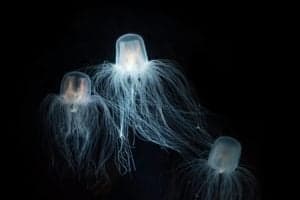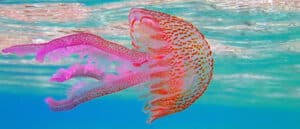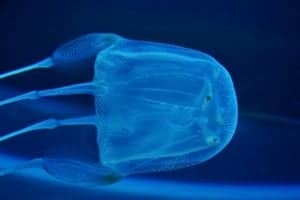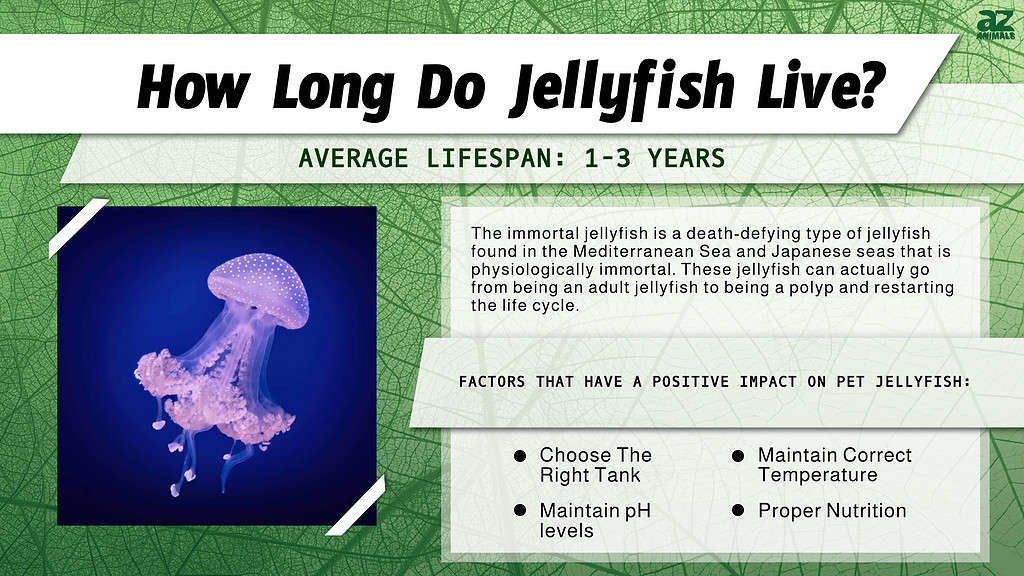
Both beautiful and intimidating, jellyfish are one of the oldest multicellular animals in the world.
Adults and kids alike find themselves in awe when looking at a jellyfish swimming around in a tank. They are both absolutely scary because their stings can hurt, and also fascinating because of their appearance. There’s a lot of mystery shrouded in the jellyfish. Particularly when it comes to the jellyfish lifespan and understanding just how long jellyfish live.
Jellyfish are so incredibly diverse and because of this, we’ve decided to run you through the lifespan and life cycle of the jellyfish. Whether you’re a jellyfish enthusiast looking to keep one as a pet, or just a casual admirer, there are lots to learn about this amazing animal.
Quick Crash Course on Jellyfish

Some jellyfish can glow in the dark.
©Nagisa GOGO 0515/Shutterstock.com
Jellyfish aren’t actually fish. They’re classified as gelatinous invertebrates. This means that they have no spine, which is why they appear fluid-like jelly. Because jellyfish lack bones, there aren’t any fossils for archeologists to dig up and study. Despite this, scientists have evidence that these organisms have been swimming about in the world’s waters for at least 500 million years. They’re so old that they even predate the dinosaurs!
Their bodies are composed of up to 98 percent water. They don’t have any of the organs that most other animals have that keep them alive. They stay alive without a brain, a heart, and even without lungs! Their bodies evaporate into the air and essentially disappear within a few hours after washing up onshore. So how long can an animal like this stay alive? Let’s dive into the jellyfish lifespan.
How Long Do Jellyfish Live?
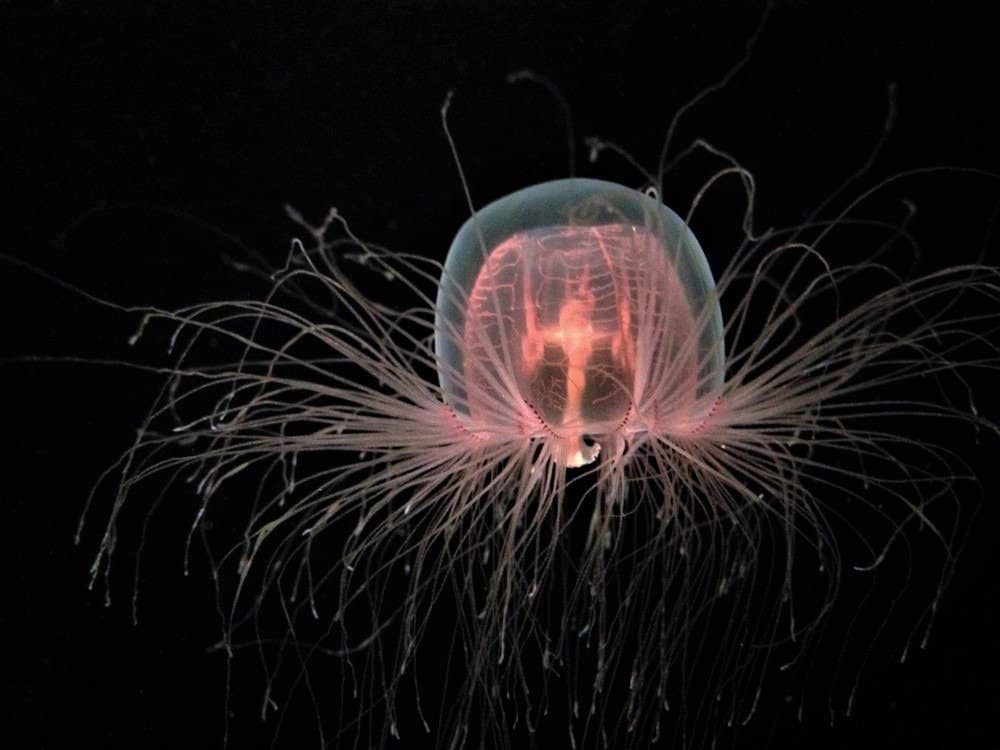
Some jellyfish are immortal.
©Rebecca Schreiner/Shutterstock.com
On average, jellyfish will live anywhere from 1-3 years. However, certain species will only live a few days while others are able to live for a few decades. However, scientists are unable to say definitively how long jellyfish live due to their complex life cycles.
Of all the fascinating aspects of the jellyfish lifespan, the most unbelievable is the immortal jellyfish. The immortal jellyfish (or Turritopsis dohrnii) is a death-defying type of jellyfish found in the Mediterranean Sea and Japanese seas that is physiologically immortal. These jellyfish can actually go from being an adult jellyfish to being a polyp and restarting the life cycle.
According to Ageing Research Reviews, “a key determinant of longevity and immortality in most of these simple animals is the large numbers of pluripotent stem cells that underlie the remarkable abilities of these animals to regenerate and rejuvenate themselves.” Pluripotent stem cells are cells that have the capacity to self-renew by dividing. This allows the immortal jellyfish to live indefinitely!
The Average Jellyfish Life Cycle
Curious about what the jellyfish life cycle looks like? Here’s a rundown of what to expect if you decide to get a pet jellyfish!
Egg
The jellyfish’s life cycle begins with eggs. Jellyfish reproduce sexually. Mature jellyfish are either male or female and have reproductive organs known as gonads. There are several different ways jellyfish species fertilize their eggs, but all include both male and female jellyfish. In some male jellyfish species, the male will discharge sperm from the mouth hole on the bottom of their bell. The eggs are then fertilized when the female swims through the sperm.
Larvae
After the female jellyfish’s eggs are fertilized by the male’s sperm, they quickly begin to hatch. Planula larvae will then make their way out of the female jellyfish’s mouth or brood pouch. The planula larva floats on the top of the water for a few days. As long as it isn’t eaten by any predators, the planula larva will begin its next development stage into a polyp.
Polyp
The planula larva will begin to settle onto the seafloor where it will begin its transformation into a polyp. The jellyfish polyp will greatly resemble coral around this time. During this stage, the polyp has a fully developed digestive system. This allows it to collect prey and feed itself properly. The polyp will continue to grow until it finally becomes a free-living organism.
Ephyrae
An ephyra is a stage right before a jellyfish becomes an adult. Unlike a fully matured jellyfish, the ephyrae lack a closed bell shape and stinging tentacles. In order to push food toward its mouth, it must rely on the undeveloped lobes of its bell.
Medusa
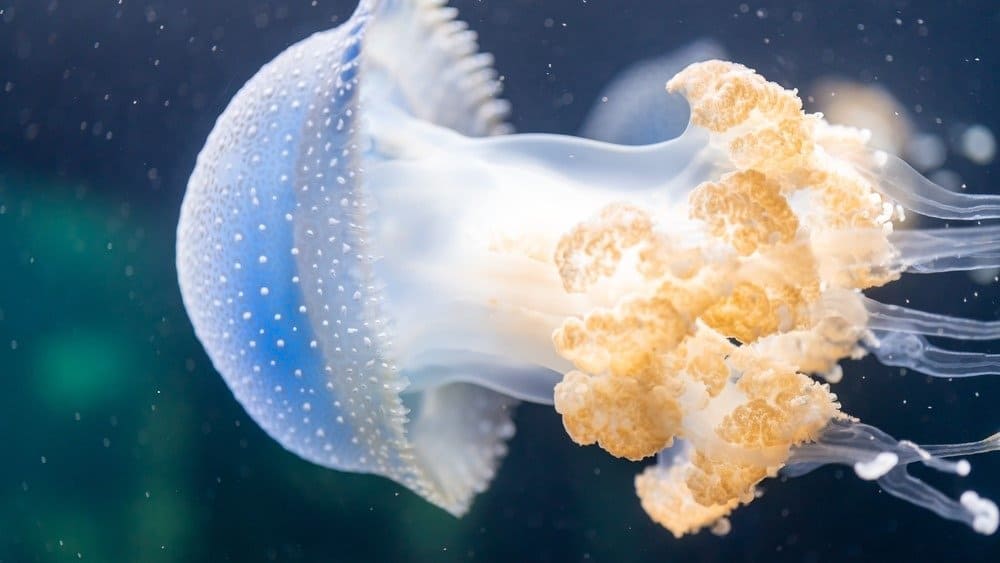
Fully matured Medusa.
©Lascha11/Shutterstock.com
As the ephyra matures, it begins to take on the shape of what we recognize as a jellyfish. It begins to form into a bell shape and grows its tentacles and oral arms. This final stage is known as a medusa. Despite its modest size, this new adult is already a mature marine animal capable of reproducing.
How To Extend the Life of Your Pet Jellyfish
Jellyfish make for a great exotic pet. Watching them float around in a tank can be absolutely mesmerizing. So if you’d like to extend the life of your pet jellyfish, then pay attention to these tips:
- Choosing the right tank: Jellyfish may injure themselves in standard fish tanks. They require a specially built jellyfish tank with curved edges and a low water flow to prevent damaging the jellyfish’s sensitive skin.
- Maintaining the correct temperature and pH levels: For your jellyfish to be healthy, it’s crucial to maintain their aquarium. Check to see whether their water is clean, deionized, and at the proper temperature and salinity. The tank temperature should be approximately 18-25 C. Water quality tests should be performed every few days after the tank is first filled with jellyfish. The pH should be between 7.9 and 8.4, and the salinity should be between 34 and 35ppt.
- Proper nutrition: Jellyfish should be fed twice a day to keep them healthy. They can eat a variety of dry, frozen, and live meals. Baby brine shrimp are a popular meal for jellyfish. They also enjoy live rotifers as a snack. You may also buy commercial jellyfish food to feed them. These can be purchased at your local pet store.
The photo featured at the top of this post is © iStock.com/vojce
Thank you for reading! Have some feedback for us? Contact the AZ Animals editorial team.



